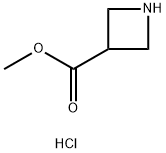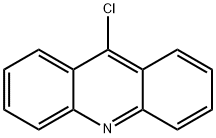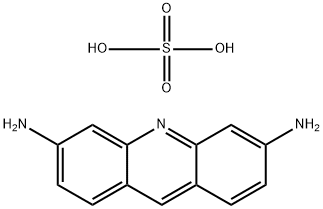A0639812
Acridine , 98% , 260-94-6
CAS NO.:260-94-6
Empirical Formula: C13H9N
Molecular Weight: 179.22
MDL number: MFCD00005025
EINECS: 205-971-6
Update time: 2022-07-08
PRODUCT Properties
| Melting point: | 106-109 °C |
| Boiling point: | 346 °C(lit.) |
| Density | 1,005 g/cm3 |
| refractive index | 1.7270 (estimate) |
| Flash point: | 346°C |
| storage temp. | Refrigerator |
| solubility | dioxane: 0.1 g/mL, clear |
| pka | 5.58(at 20℃) |
| form | Crystalline Powder |
| color | Yellow to yellow-brown |
| PH Range | Green B uorescence (5.2) to violet B uorescence (6.6) |
| Water Solubility | 57.35mg/L(24 ºC) |
| λmax | 358nm, 392nm |
| Merck | 14,122 |
| BRN | 120200 |
| Exposure limits | OSHA: TWA 0.2 mg/m3 |
| Stability: | Stable. Combustible. Incompatible with strong oxidizing agents. |
| Major Application | Organic light-emitting diode, photoresists, nanosensors, fuel cells, memory device, semiconductors, information storage device, liquid crystal displays, identification of product forgeries, inks, adhesives, textile, hair dyes, gene detection assay, staining cells, biosensors, detecting nucleic acids, proteins, antiHCV antibodies, antibacterial, antiamyloid agents, wound dressing materials, vaccines against infection, allergy and cancer |
| InChIKey | DZBUGLKDJFMEHC-UHFFFAOYSA-N |
| LogP | 3.400 |
| CAS DataBase Reference | 260-94-6(CAS DataBase Reference) |
| EPA Substance Registry System | Acridine (260-94-6) |
Description and Uses
Acridine is a compound occurring in coal tar that has been used in the manufacture of dyes and intermediates. Derivatives are used as antiseptics (e.g., proflavine). Acridine is a strong irritant to mucous membranes and skin, and it causes sneezing on inhalation.
Safety
| Symbol(GHS) |   GHS07,GHS09 |
| Signal word | Warning |
| Hazard statements | H302-H315-H319-H335-H410 |
| Precautionary statements | P261-P264-P273-P301+P312-P302+P352-P305+P351+P338 |
| Hazard Codes | Xn |
| Risk Statements | 22-68-36/37/38 |
| Safety Statements | 22-36-45-36/37/39-26 |
| RIDADR | UN 2713 6.1/PG 3 |
| WGK Germany | 3 |
| RTECS | AR7175000 |
| TSCA | Yes |
| HazardClass | 6.1 |
| PackingGroup | III |
| HS Code | 29333990 |
| Hazardous Substances Data | 260-94-6(Hazardous Substances Data) |
| Toxicity | LD50 s.c. in mice: 0.40 g/kg (Rubbo) |
| Limited Quantities | 5.0 L (1.3 gallons) (liquid) or 5.0 kg (11 lbs) (solid) |
| Excepted Quantities | Max Inner Pack (30g or 30ml) and Max Outer Pack (1Kg or 1L) |






